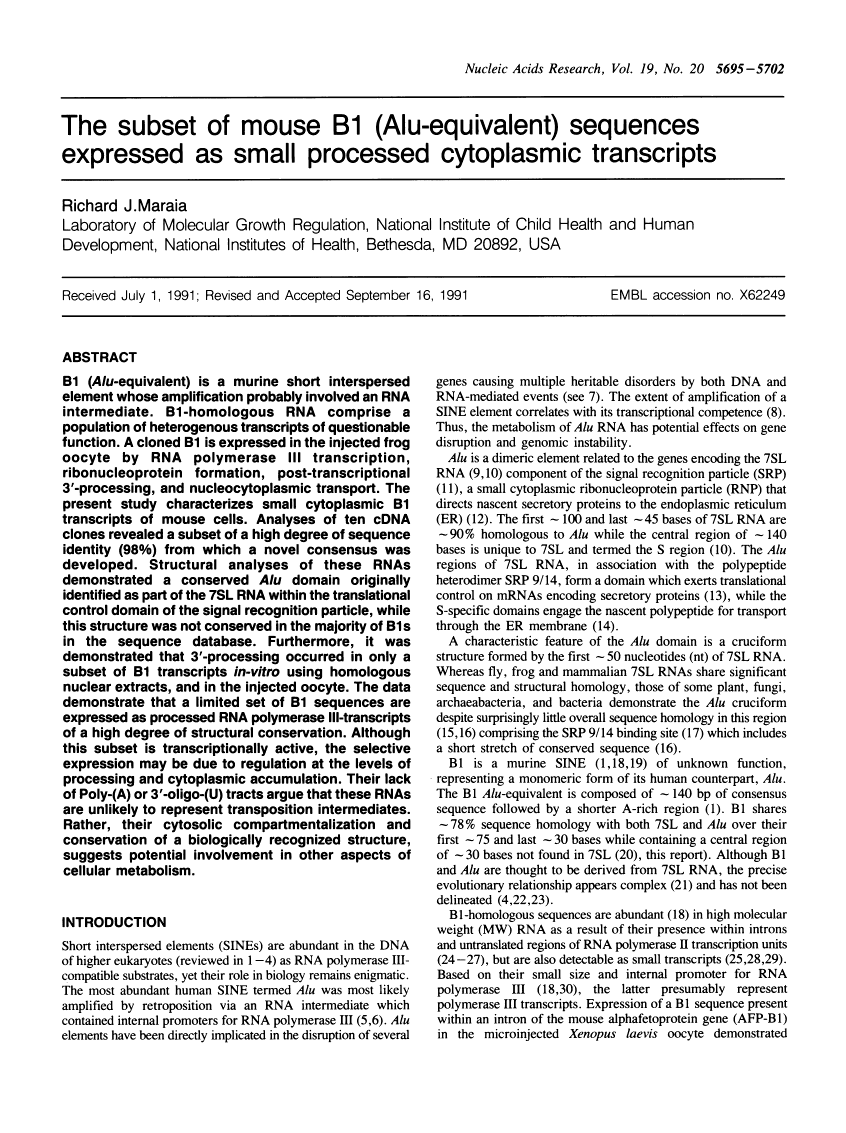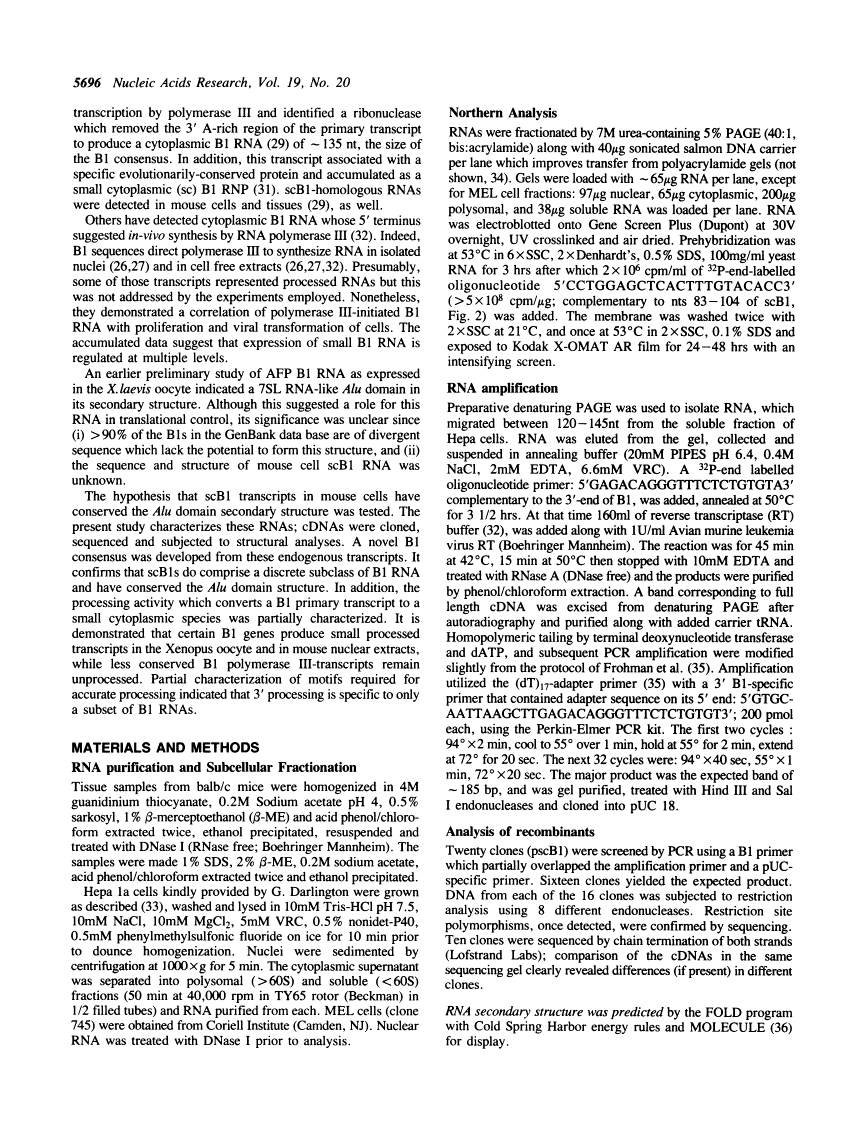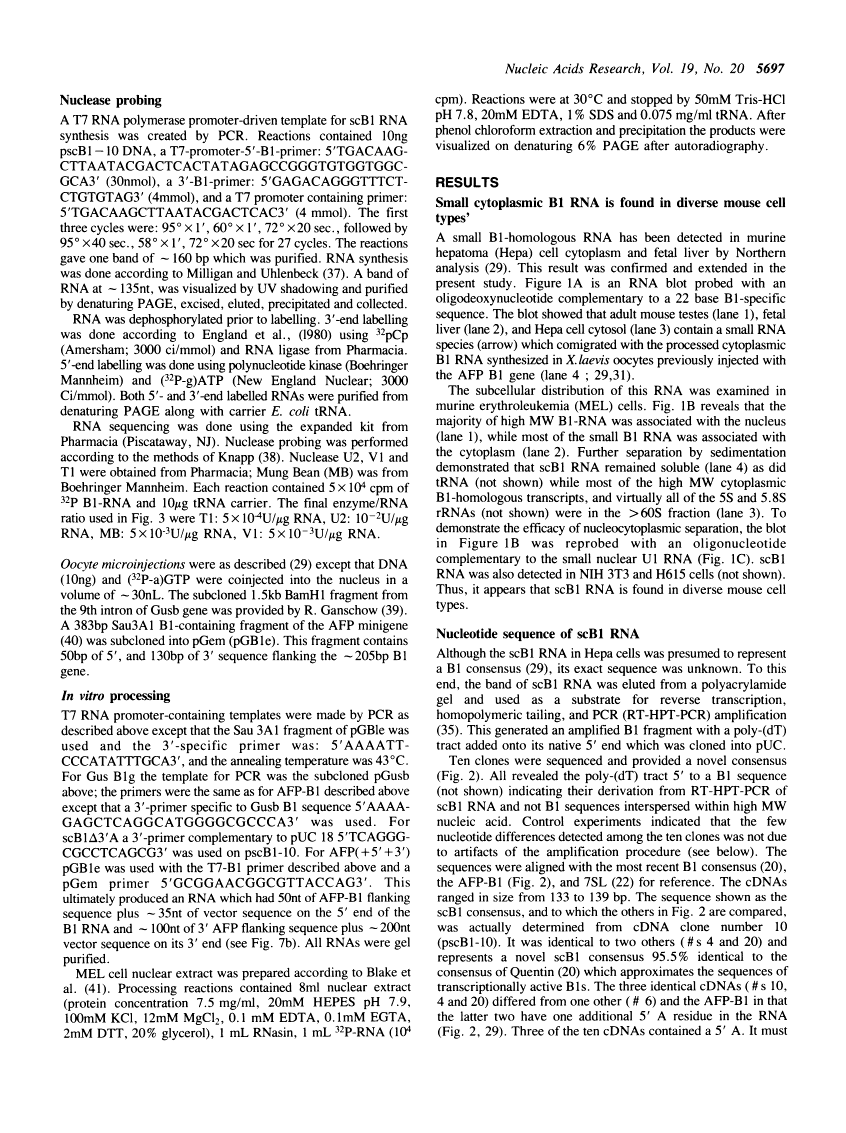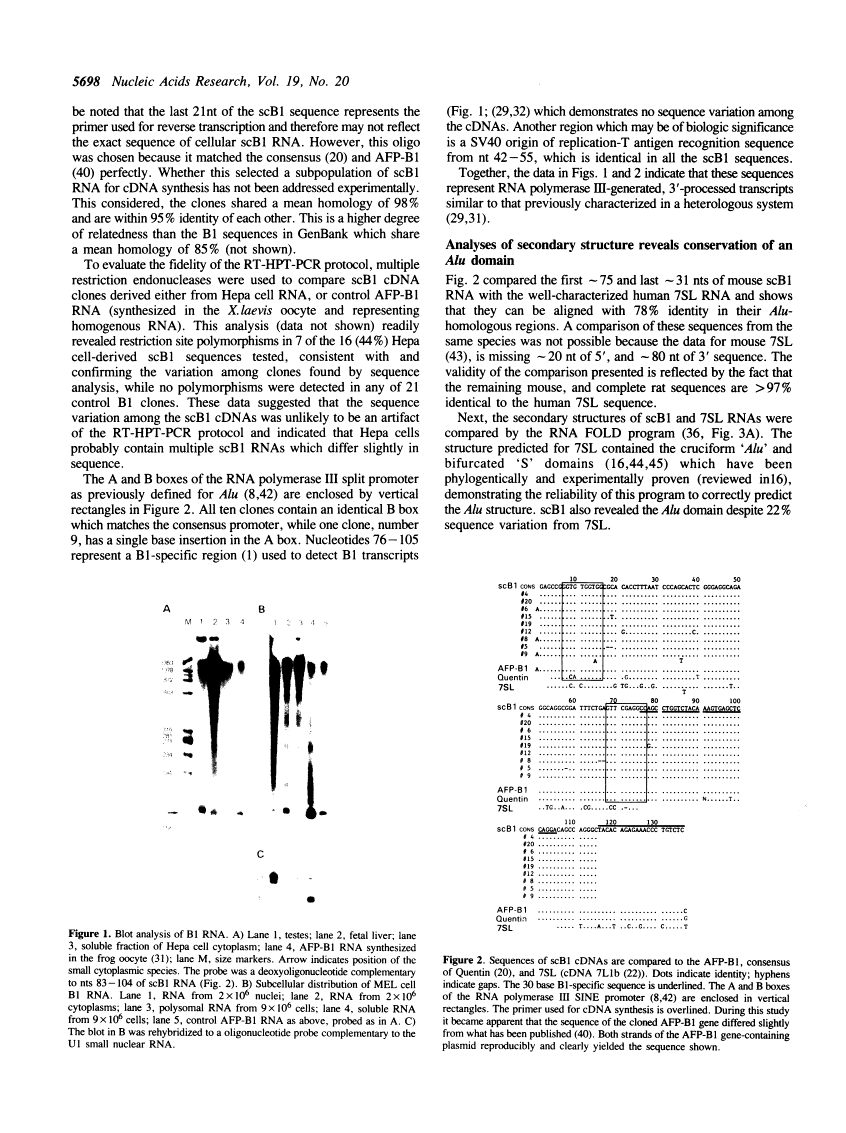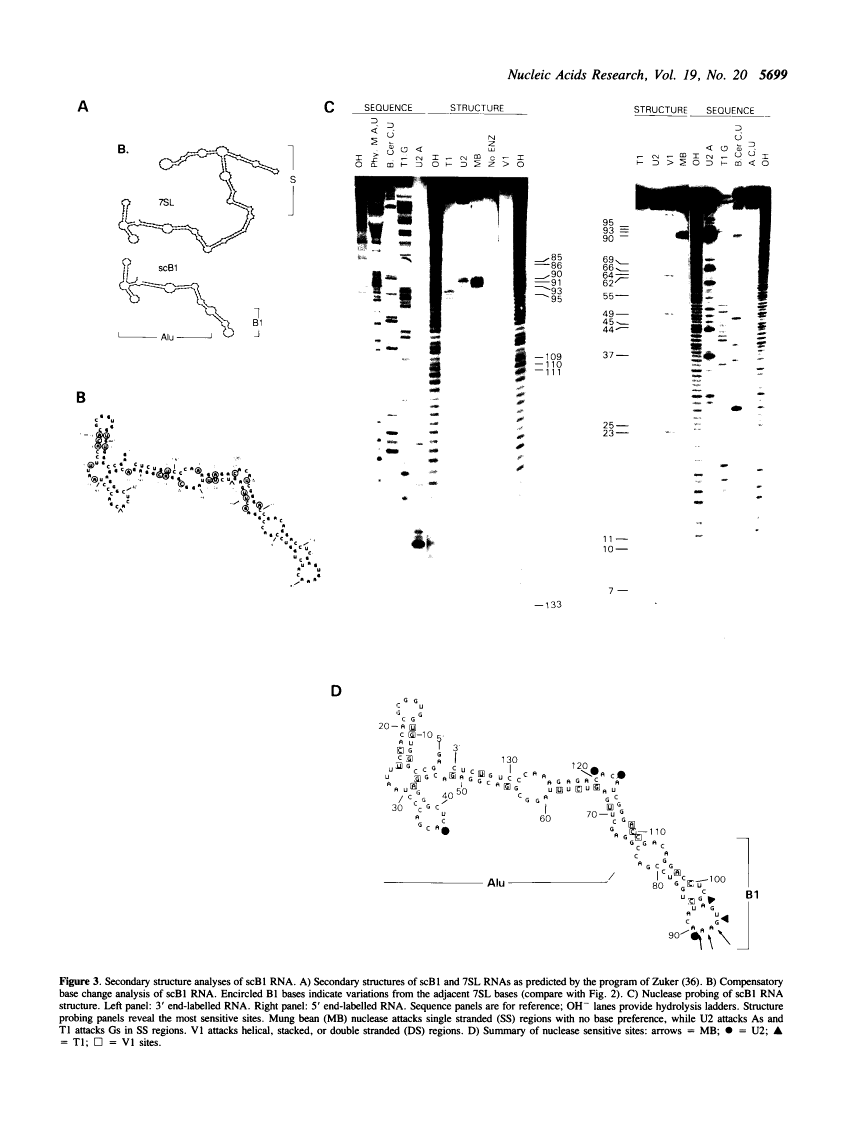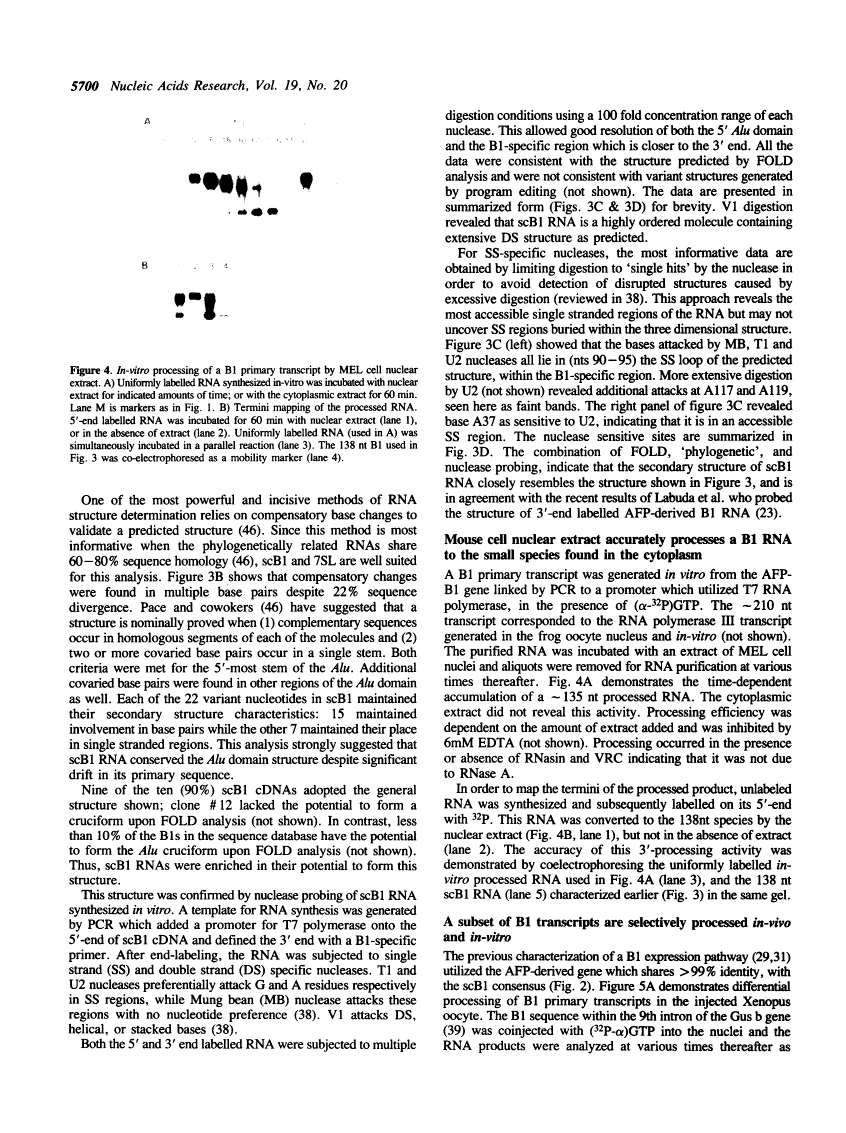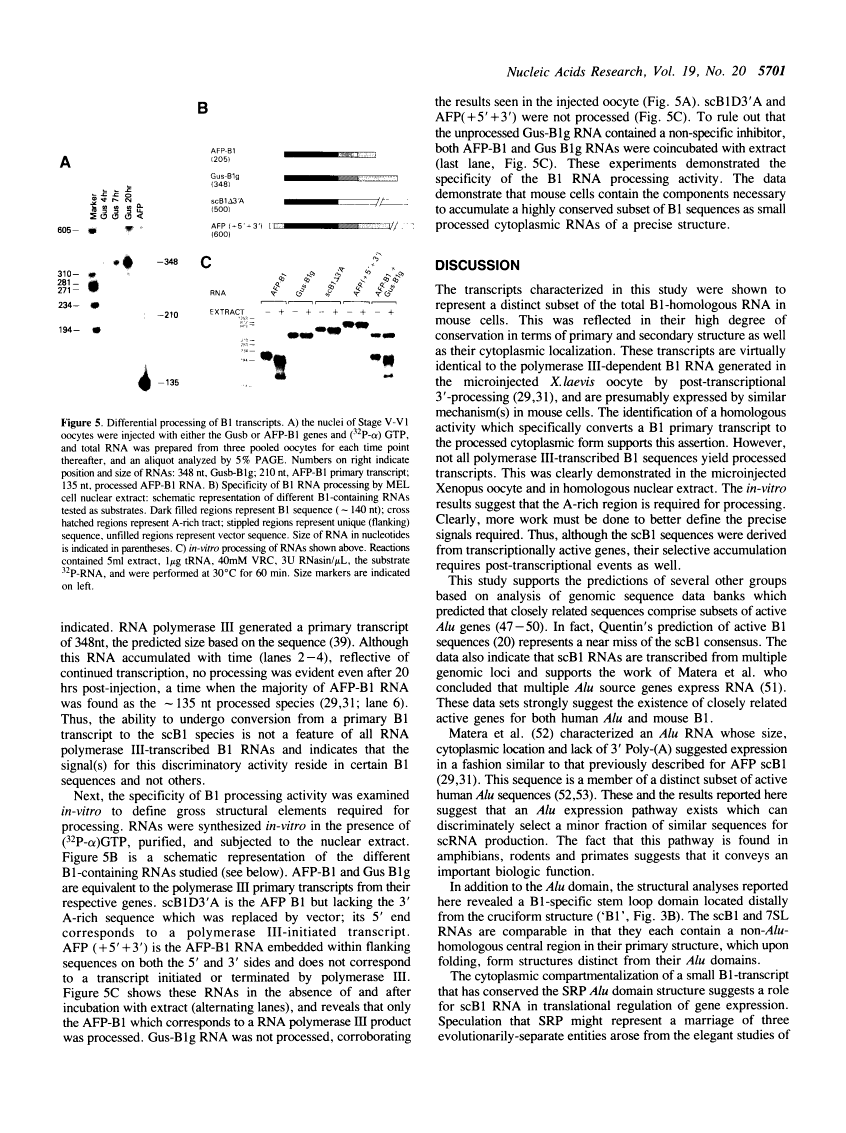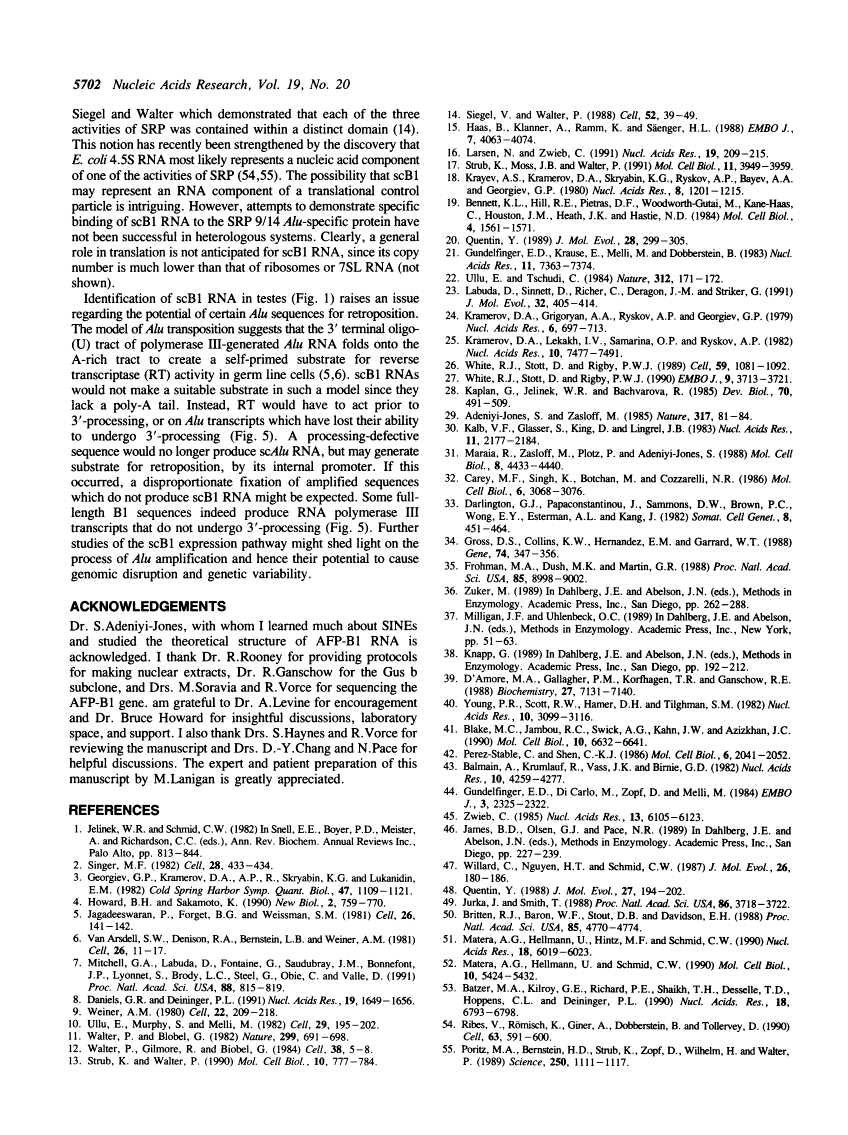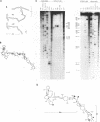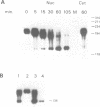Abstract
Free full text

The subset of mouse B1 (Alu-equivalent) sequences expressed as small processed cytoplasmic transcripts.
Abstract
B1 (Alu-equivalent) is a murine short interspersed element whose amplification probably involved an RNA intermediate. B1-homologous RNA comprise a population of heterogenous transcripts of questionable function. A cloned B1 is expressed in the injected frog oocyte by RNA polymerase III transcription, ribonucleoprotein formation, post-transcriptional 3'-processing, and nucleocytoplasmic transport. The present study characterizes small cytoplasmic B1 transcripts of mouse cells. Analyses of ten cDNA clones revealed a subset of a high degree of sequence identity (98%) from which a novel consensus was developed. Structural analyses of these RNAs demonstrated a conserved Alu domain originally identified as part of the 7SL RNA within the translational control domain of the signal recognition particle, while this structure was not conserved in the majority of B1s in the sequence database. Furthermore, it was demonstrated that 3'-processing occurred in only a subset of B1 transcripts in-vitro using homologous nuclear extracts, and in the injected oocyte. The data demonstrate that a limited set of B1 sequences are expressed as processed RNA polymerase III-transcripts of a high degree of structural conservation. Although this subset is transcriptionally active, the selective expression may be due to regulation at the levels of processing and cytoplasmic accumulation. Their lack of Poly-(A) or 3'-oligo-(U) tracts argue that these RNAs are unlikely to represent transposition intermediates. Rather, their cytosolic compartmentalization and conservation of a biologically recognized structure, suggests potential involvement in other aspects of cellular metabolism.
Full text
Full text is available as a scanned copy of the original print version. Get a printable copy (PDF file) of the complete article (2.1M), or click on a page image below to browse page by page. Links to PubMed are also available for Selected References.
Images in this article
Click on the image to see a larger version.
Selected References
These references are in PubMed. This may not be the complete list of references from this article.
- Jelinek WR, Schmid CW. Repetitive sequences in eukaryotic DNA and their expression. Annu Rev Biochem. 1982;51:813–844. [Abstract] [Google Scholar]
- Singer MF. SINEs and LINEs: highly repeated short and long interspersed sequences in mammalian genomes. Cell. 1982 Mar;28(3):433–434. [Abstract] [Google Scholar]
- Georgiev GP, Kramerov DA, Ryskov AP, Skryabin KG, Lukanidin EM. Dispersed repetitive sequences in eukaryotic genomes and their possible biological significance. Cold Spring Harb Symp Quant Biol. 1983;47(Pt 2):1109–1121. [Abstract] [Google Scholar]
- Howard BH, Sakamoto K. Alu interspersed repeats: selfish DNA or a functional gene family? New Biol. 1990 Sep;2(9):759–770. [Abstract] [Google Scholar]
- Jagadeeswaran P, Forget BG, Weissman SM. Short interspersed repetitive DNA elements in eucaryotes: transposable DNA elements generated by reverse transcription of RNA pol III transcripts? Cell. 1981 Oct;26(2 Pt 2):141–142. [Abstract] [Google Scholar]
- Van Arsdell SW, Denison RA, Bernstein LB, Weiner AM, Manser T, Gesteland RF. Direct repeats flank three small nuclear RNA pseudogenes in the human genome. Cell. 1981 Oct;26(1 Pt 1):11–17. [Abstract] [Google Scholar]
- Mitchell GA, Labuda D, Fontaine G, Saudubray JM, Bonnefont JP, Lyonnet S, Brody LC, Steel G, Obie C, Valle D. Splice-mediated insertion of an Alu sequence inactivates ornithine delta-aminotransferase: a role for Alu elements in human mutation. Proc Natl Acad Sci U S A. 1991 Feb 1;88(3):815–819. [Europe PMC free article] [Abstract] [Google Scholar]
- Daniels GR, Deininger PL. Characterization of a third major SINE family of repetitive sequences in the galago genome. Nucleic Acids Res. 1991 Apr 11;19(7):1649–1656. [Europe PMC free article] [Abstract] [Google Scholar]
- Weiner AM. An abundant cytoplasmic 7S RNA is complementary to the dominant interspersed middle repetitive DNA sequence family in the human genome. Cell. 1980 Nov;22(1 Pt 1):209–218. [Abstract] [Google Scholar]
- Ullu E, Murphy S, Melli M. Human 7SL RNA consists of a 140 nucleotide middle-repetitive sequence inserted in an alu sequence. Cell. 1982 May;29(1):195–202. [Abstract] [Google Scholar]
- Walter P, Blobel G. Signal recognition particle contains a 7S RNA essential for protein translocation across the endoplasmic reticulum. Nature. 1982 Oct 21;299(5885):691–698. [Abstract] [Google Scholar]
- Walter P, Gilmore R, Blobel G. Protein translocation across the endoplasmic reticulum. Cell. 1984 Aug;38(1):5–8. [Abstract] [Google Scholar]
- Strub K, Walter P. Assembly of the Alu domain of the signal recognition particle (SRP): dimerization of the two protein components is required for efficient binding to SRP RNA. Mol Cell Biol. 1990 Feb;10(2):777–784. [Europe PMC free article] [Abstract] [Google Scholar]
- Siegel V, Walter P. Each of the activities of signal recognition particle (SRP) is contained within a distinct domain: analysis of biochemical mutants of SRP. Cell. 1988 Jan 15;52(1):39–49. [Abstract] [Google Scholar]
- Haas B, Klanner A, Ramm K, Sänger HL. The 7S RNA from tomato leaf tissue resembles a signal recognition particle RNA and exhibits a remarkable sequence complementarity to viroids. EMBO J. 1988 Dec 20;7(13):4063–4074. [Europe PMC free article] [Abstract] [Google Scholar]
- Larsen N, Zwieb C. SRP-RNA sequence alignment and secondary structure. Nucleic Acids Res. 1991 Jan 25;19(2):209–215. [Europe PMC free article] [Abstract] [Google Scholar]
- Strub K, Moss J, Walter P. Binding sites of the 9- and 14-kilodalton heterodimeric protein subunit of the signal recognition particle (SRP) are contained exclusively in the Alu domain of SRP RNA and contain a sequence motif that is conserved in evolution. Mol Cell Biol. 1991 Aug;11(8):3949–3959. [Europe PMC free article] [Abstract] [Google Scholar]
- Krayev AS, Kramerov DA, Skryabin KG, Ryskov AP, Bayev AA, Georgiev GP. The nucleotide sequence of the ubiquitous repetitive DNA sequence B1 complementary to the most abundant class of mouse fold-back RNA. Nucleic Acids Res. 1980 Mar 25;8(6):1201–1215. [Europe PMC free article] [Abstract] [Google Scholar]
- Bennett KL, Hill RE, Pietras DF, Woodworth-Gutai M, Kane-Haas C, Houston JM, Heath JK, Hastie ND. Most highly repeated dispersed DNA families in the mouse genome. Mol Cell Biol. 1984 Aug;4(8):1561–1571. [Europe PMC free article] [Abstract] [Google Scholar]
- Quentin Y. Successive waves of fixation of B1 variants in rodent lineage history. J Mol Evol. 1989 Apr;28(4):299–305. [Abstract] [Google Scholar]
- Gundelfinger ED, Krause E, Melli M, Dobberstein B. The organization of the 7SL RNA in the signal recognition particle. Nucleic Acids Res. 1983 Nov 11;11(21):7363–7374. [Europe PMC free article] [Abstract] [Google Scholar]
- Ullu E, Tschudi C. Alu sequences are processed 7SL RNA genes. Nature. 1984 Nov 8;312(5990):171–172. [Abstract] [Google Scholar]
- Labuda D, Sinnett D, Richer C, Deragon JM, Striker G. Evolution of mouse B1 repeats: 7SL RNA folding pattern conserved. J Mol Evol. 1991 May;32(5):405–414. [Abstract] [Google Scholar]
- Kramerov DA, Grigoryan AA, Ryskov AP, Georgiev GP. Long double-stranded sequences (dsRNA-B) of nuclear pre-mRNA consist of a few highly abundant classes of sequences: evidence from DNA cloning experiments. Nucleic Acids Res. 1979 Feb;6(2):697–713. [Europe PMC free article] [Abstract] [Google Scholar]
- Kramerov DA, Lekakh IV, Samarina OP, Ryskov AP. The sequences homologous to major interspersed repeats B1 and B2 of mouse genome are present in mRNA and small cytoplasmic poly(A) + RNA. Nucleic Acids Res. 1982 Dec 11;10(23):7477–7491. [Europe PMC free article] [Abstract] [Google Scholar]
- White RJ, Stott D, Rigby PW. Regulation of RNA polymerase III transcription in response to F9 embryonal carcinoma stem cell differentiation. Cell. 1989 Dec 22;59(6):1081–1092. [Abstract] [Google Scholar]
- White RJ, Stott D, Rigby PW. Regulation of RNA polymerase III transcription in response to Simian virus 40 transformation. EMBO J. 1990 Nov;9(11):3713–3721. [Europe PMC free article] [Abstract] [Google Scholar]
- Adeniyi-Jones S, Zasloff M. Transcription, processing and nuclear transport of a B1 Alu RNA species complementary to an intron of the murine alpha-fetoprotein gene. Nature. 1985 Sep 5;317(6032):81–84. [Abstract] [Google Scholar]
- Kalb VF, Glasser S, King D, Lingrel JB. A cluster of repetitive elements within a 700 base pair region in the mouse genome. Nucleic Acids Res. 1983 Apr 11;11(7):2177–2184. [Europe PMC free article] [Abstract] [Google Scholar]
- Maraia R, Zasloff M, Plotz P, Adeniyi-Jones S. Pathway of B1-Alu expression in microinjected oocytes: Xenopus laevis proteins associated with nuclear precursor and processed cytoplasmic RNAs. Mol Cell Biol. 1988 Oct;8(10):4433–4440. [Europe PMC free article] [Abstract] [Google Scholar]
- Carey MF, Singh K, Botchan M, Cozzarelli NR. Induction of specific transcription by RNA polymerase III in transformed cells. Mol Cell Biol. 1986 Sep;6(9):3068–3076. [Europe PMC free article] [Abstract] [Google Scholar]
- Darlington GJ, Papaconstantinou J, Sammons DW, Brown PC, Wong EY, Esterman AL, Kang J. Generation and chracterization of variants of mouse hepatoma cells with defects in hepato-specific gene expression. I. Albumin synthesis variants. Somatic Cell Genet. 1982 Jul;8(4):451–464. [Abstract] [Google Scholar]
- Gross DS, Collins KW, Hernandez EM, Garrard WT. Vacuum blotting: a simple method for transferring DNA from sequencing gels to nylon membranes. Gene. 1988 Dec 30;74(2):347–356. [Abstract] [Google Scholar]
- Frohman MA, Dush MK, Martin GR. Rapid production of full-length cDNAs from rare transcripts: amplification using a single gene-specific oligonucleotide primer. Proc Natl Acad Sci U S A. 1988 Dec;85(23):8998–9002. [Europe PMC free article] [Abstract] [Google Scholar]
- Zuker M. Computer prediction of RNA structure. Methods Enzymol. 1989;180:262–288. [Abstract] [Google Scholar]
- Knapp G. Enzymatic approaches to probing of RNA secondary and tertiary structure. Methods Enzymol. 1989;180:192–212. [Abstract] [Google Scholar]
- D'Amore MA, Gallagher PM, Korfhagen TR, Ganschow RE. Complete sequence and organization of the murine beta-glucuronidase gene. Biochemistry. 1988 Sep 6;27(18):7131–7140. [Abstract] [Google Scholar]
- Young PR, Scott RW, Hamer DH, Tilghman SM. Construction and expression in vivo of an internally deleted mouse alpha-fetoprotein gene: presence of a transcribed Alu-like repeat within the first intervening sequence. Nucleic Acids Res. 1982 May 25;10(10):3099–3116. [Europe PMC free article] [Abstract] [Google Scholar]
- Blake MC, Jambou RC, Swick AG, Kahn JW, Azizkhan JC. Transcriptional initiation is controlled by upstream GC-box interactions in a TATAA-less promoter. Mol Cell Biol. 1990 Dec;10(12):6632–6641. [Europe PMC free article] [Abstract] [Google Scholar]
- Perez-Stable C, Shen CK. Competitive and cooperative functioning of the anterior and posterior promoter elements of an Alu family repeat. Mol Cell Biol. 1986 Jun;6(6):2041–2052. [Europe PMC free article] [Abstract] [Google Scholar]
- Balmain A, Krumlauf R, Vass JK, Birnie GD. Cloning and characterisation of the abundant cytoplasmic 7S RNA from mouse cells. Nucleic Acids Res. 1982 Jul 24;10(14):4259–4277. [Europe PMC free article] [Abstract] [Google Scholar]
- Gundelfinger ED, Di Carlo M, Zopf D, Melli M. Structure and evolution of the 7SL RNA component of the signal recognition particle. EMBO J. 1984 Oct;3(10):2325–2332. [Europe PMC free article] [Abstract] [Google Scholar]
- Zwieb C. The secondary structure of the 7SL RNA in the signal recognition particle: functional implications. Nucleic Acids Res. 1985 Sep 11;13(17):6105–6124. [Europe PMC free article] [Abstract] [Google Scholar]
- Willard C, Nguyen HT, Schmid CW. Existence of at least three distinct Alu subfamilies. J Mol Evol. 1987;26(3):180–186. [Abstract] [Google Scholar]
- Quentin Y. The Alu family developed through successive waves of fixation closely connected with primate lineage history. J Mol Evol. 1988;27(3):194–202. [Abstract] [Google Scholar]
- Britten RJ, Baron WF, Stout DB, Davidson EH. Sources and evolution of human Alu repeated sequences. Proc Natl Acad Sci U S A. 1988 Jul;85(13):4770–4774. [Europe PMC free article] [Abstract] [Google Scholar]
- Matera AG, Hellmann U, Hintz MF, Schmid CW. Recently transposed Alu repeats result from multiple source genes. Nucleic Acids Res. 1990 Oct 25;18(20):6019–6023. [Europe PMC free article] [Abstract] [Google Scholar]
- Matera AG, Hellmann U, Schmid CW. A transpositionally and transcriptionally competent Alu subfamily. Mol Cell Biol. 1990 Oct;10(10):5424–5432. [Europe PMC free article] [Abstract] [Google Scholar]
- Batzer MA, Kilroy GE, Richard PE, Shaikh TH, Desselle TD, Hoppens CL, Deininger PL. Structure and variability of recently inserted Alu family members. Nucleic Acids Res. 1990 Dec 11;18(23):6793–6798. [Europe PMC free article] [Abstract] [Google Scholar]
- Ribes V, Römisch K, Giner A, Dobberstein B, Tollervey D. E. coli 4.5S RNA is part of a ribonucleoprotein particle that has properties related to signal recognition particle. Cell. 1990 Nov 2;63(3):591–600. [Abstract] [Google Scholar]
- Poritz MA, Bernstein HD, Strub K, Zopf D, Wilhelm H, Walter P. An E. coli ribonucleoprotein containing 4.5S RNA resembles mammalian signal recognition particle. Science. 1990 Nov 23;250(4984):1111–1117. [Abstract] [Google Scholar]
Associated Data
Articles from Nucleic Acids Research are provided here courtesy of Oxford University Press
Full text links
Read article at publisher's site: https://doi.org/10.1093/nar/19.20.5695
Read article for free, from open access legal sources, via Unpaywall:
https://europepmc.org/articles/pmc328977?pdf=render
Citations & impact
Impact metrics
Citations of article over time
Article citations
Variable patterns of retrotransposition in different HeLa strains provide mechanistic insights into SINE RNA mobilization processes.
Nucleic Acids Res, 52(13):7761-7779, 01 Jul 2024
Cited by: 1 article | PMID: 38850156 | PMCID: PMC11260458
A versatile tRNA modification-sensitive northern blot method with enhanced performance.
RNA, 28(3):418-432, 20 Dec 2021
Cited by: 3 articles | PMID: 34930808 | PMCID: PMC8848930
The nuclear and cytoplasmic activities of RNA polymerase III, and an evolving transcriptome for surveillance.
Nucleic Acids Res, 49(21):12017-12034, 01 Dec 2021
Cited by: 18 articles | PMID: 34850129 | PMCID: PMC8643620
A Mechanism Leading to Changes in Copy Number Variations Affected by Transcriptional Level Might Be Involved in Evolution, Embryonic Development, Senescence, and Oncogenesis Mediated by Retrotransposons.
Front Cell Dev Biol, 9:618113, 11 Feb 2021
Cited by: 2 articles | PMID: 33644055 | PMCID: PMC7905054
Host Noncoding Retrotransposons Induced by DNA Viruses: a SINE of Infection?
J Virol, 91(23):e00982-17, 14 Nov 2017
Cited by: 10 articles | PMID: 28931686 | PMCID: PMC5686761
Review Free full text in Europe PMC
Go to all (46) article citations
Data
Data behind the article
This data has been text mined from the article, or deposited into data resources.
BioStudies: supplemental material and supporting data
Similar Articles
To arrive at the top five similar articles we use a word-weighted algorithm to compare words from the Title and Abstract of each citation.
The RNA polymerase III terminator used by a B1-Alu element can modulate 3' processing of the intermediate RNA product.
Mol Cell Biol, 12(4):1500-1506, 01 Apr 1992
Cited by: 33 articles | PMID: 1549107 | PMCID: PMC369591
A cellular protein binds B1 and Alu small cytoplasmic RNAs in vitro.
J Biol Chem, 268(9):6423-6428, 01 Mar 1993
Cited by: 35 articles | PMID: 7681065
Multiple dispersed loci produce small cytoplasmic Alu RNA.
Mol Cell Biol, 13(7):4233-4241, 01 Jul 1993
Cited by: 54 articles | PMID: 7686619 | PMCID: PMC359973
Transcriptional regulation and transpositional selection of active SINE sequences.
Curr Opin Genet Dev, 2(6):874-882, 01 Dec 1992
Cited by: 97 articles | PMID: 1335809
Review
